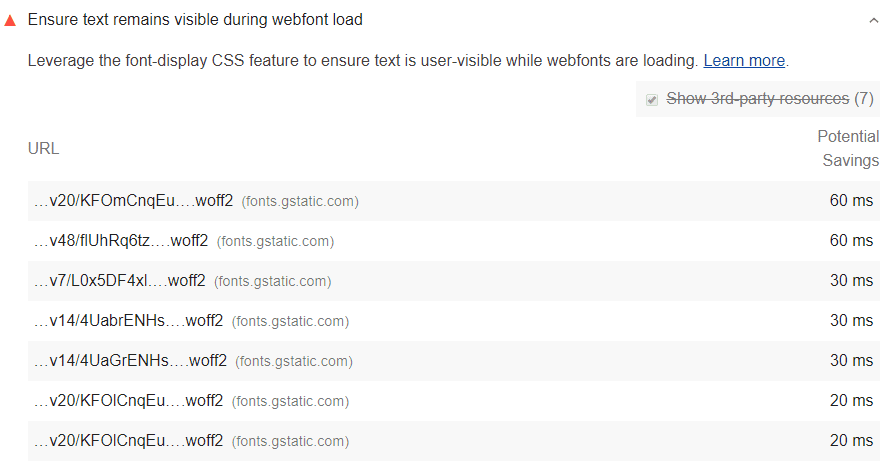Fonts are often large files with slow load times. Some browsers hide text until the font loads, causing a flash of invisible text (FOIT).
How the Lighthouse font-display audit fails
Lighthouse flags any font URLs that may flash invisible text:

How to avoid showing invisible text
The font-display API indicates
how a font is displayed when used inside a font-face style. The following
font-display values will tell the browser to use a system font if the custom font is not ready:
swapoptionalfallback
CSS Example
@font-face {
font-family: 'Pacifico';
font-style: normal;
font-weight: 400;
src: local('Pacifico Regular'), local('Pacifico-Regular'),
url(https://fonts.gstatic.com/s/pacifico/v12/FwZY7-Qmy14u9lezJ-6H6MmBp0u-.woff2)
format('woff2');
font-display: swap;
}
Google Fonts Example
Add the &display=swap/&display=optional/&display=fallback parameter to the end of your Google Fonts URL:
<link
href="https://fonts.googleapis.com/css?family=Roboto:400,700&display=swap"
rel="stylesheet"
/>
How to avoid layout shifts caused by deferred fonts
Temporarily showing a system font will replace a FOIT with a flash of unstyled text (FOUT). This improves FCP&LCP by rendering content sooner, but FOIT and FOUT will both have the same impact on CLS when the custom font replaces the temporary system font.
The CLS impact of font loading can be mitigated using preloads in conjunction with font-display: optional.
However, overusing preloads can negatively impact load metrics. We recommend performing A/B testing to ensure that preloading fonts does not introduce any
performance regressions.
Stack-specific guidance
Drupal
Specify @font-display when defining custom fonts in your theme.
Magento
Specify @font-display when defining custom fonts.
